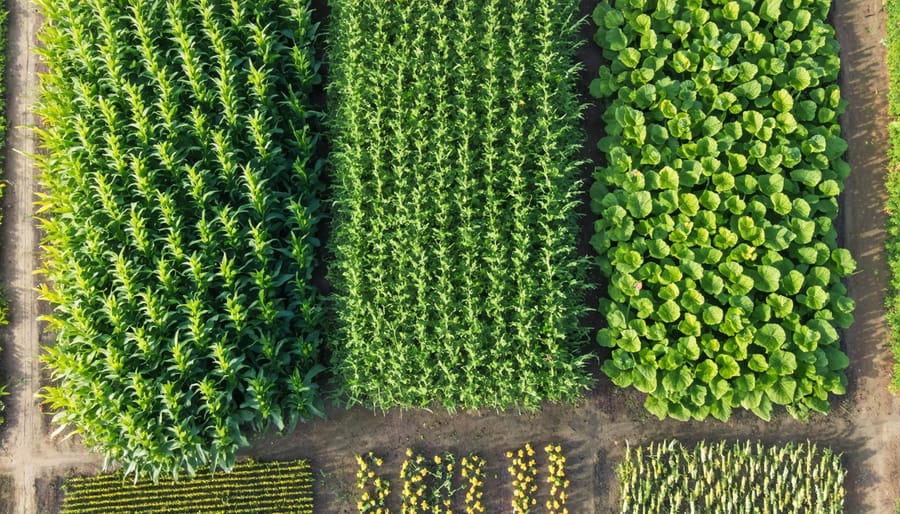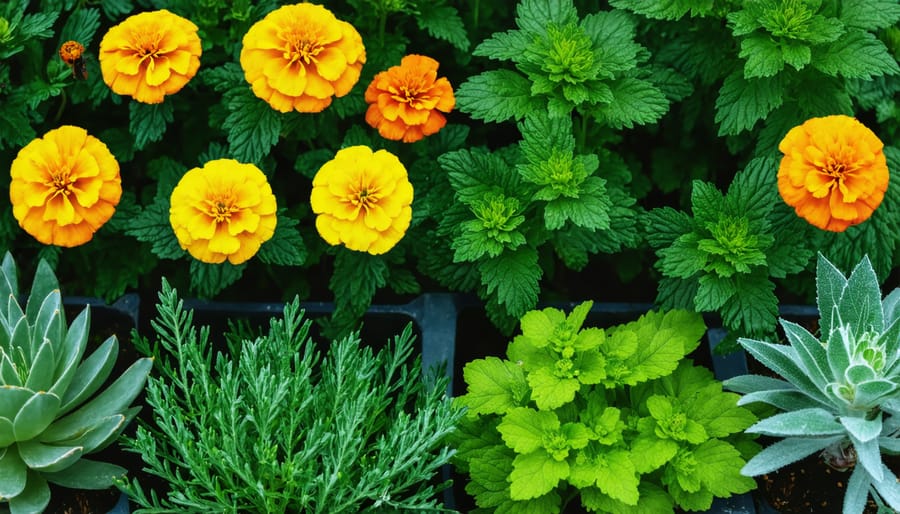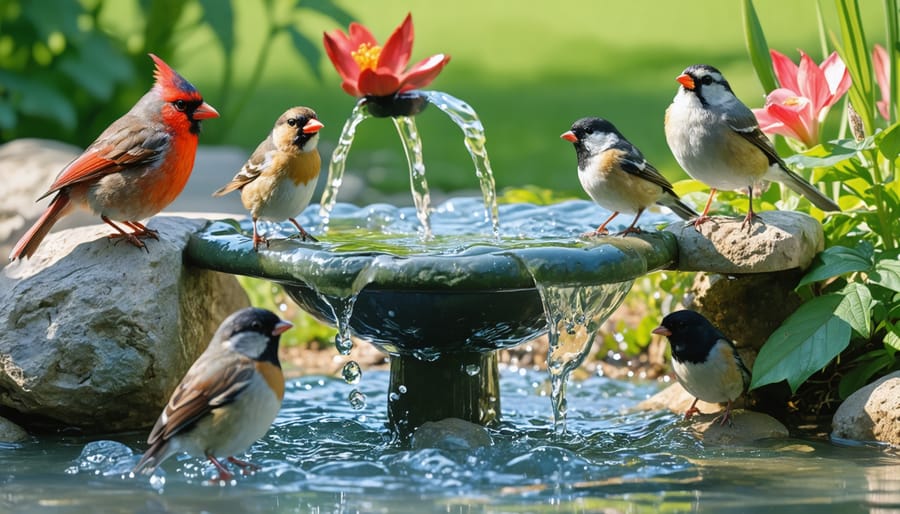Plant the “Three Sisters” – corn, beans, and squash – in companion groups, allowing the corn to support climbing beans while squash spreads below to retain moisture and suppress weeds. Build raised mounds 4-6 inches high and 4 feet in diameter, incorporating fish scraps or bone meal to enrich the soil naturally as Indigenous peoples did for centuries. Implement native garden techniques like deep mulching with fallen leaves and pine needles, creating a self-sustaining ecosystem that requires minimal watering. Practice succession planting by saving seeds from the strongest plants each season, gradually developing varieties perfectly adapted to your local climate – just as Native Americans did through generations of careful selection.
These time-tested methods don’t just grow food; they build living soil, support pollinators, and create resilient gardens that work with nature rather than against it. Each technique has been refined over thousands of years to maximize yields while minimizing environmental impact, offering modern gardeners a blueprint for sustainable success.

The Three Sisters Method: Nature’s Perfect Companion Planting
How Corn, Beans, and Squash Work Together
The Three Sisters planting method – combining corn, beans, and squash – is one of the most brilliant examples of the benefits of biodiversity in traditional gardening. These three plants work together in perfect harmony, each supporting the others in a natural partnership that enhances growth and soil health.
Tall corn stalks act as natural trellises for climbing beans, eliminating the need for artificial supports. As the beans grow, they wrap themselves around the corn, adding stability to prevent the tall stalks from toppling over in strong winds. But the beans don’t just take – they give back by fixing nitrogen in the soil, feeding both the corn and squash throughout the growing season.
Meanwhile, large squash leaves spread across the ground, creating a living mulch that helps retain soil moisture and suppress weeds. Their prickly stems and leaves also help deter pests like raccoons and other wildlife that might be interested in the corn. The shade from the squash leaves keeps the soil cool and reduces water evaporation, creating an ideal microclimate for all three plants.
This companion planting system demonstrates how working with nature, rather than against it, can create a more resilient and productive garden while reducing the need for external inputs like fertilizers and pest control.
Modern Adaptations for Your Garden
The Three Sisters gardening method can be beautifully adapted to modern gardens of any size. Start by selecting a sunny spot in your yard that’s at least 4 feet by 4 feet – though larger spaces will yield more abundant harvests. The key is to plant in mounds rather than traditional rows, with each mound about 4 feet apart.
Begin by creating soil mounds that are roughly 12 inches high and 18 inches wide. In early spring, plant 4-5 corn seeds in the center of each mound, spacing them about 6 inches apart in a circle. Once the corn reaches about 6 inches tall (typically after 2-3 weeks), plant pole bean seeds around each cornstalk. The beans will naturally climb the corn as they grow.
A week later, plant squash or pumpkin seeds around the base of the mound. Choose compact varieties if you’re working with limited space. Modern gardeners can enhance this system by adding a layer of mulch around the plants to retain moisture and suppress weeds – a contemporary twist on the traditional method.
For urban gardeners, this system can be modified for raised beds or container gardens. Use dwarf corn varieties and bush beans if vertical space is limited. Remember to water deeply but infrequently, encouraging strong root development. Adding a balanced organic fertilizer at planting time can help ensure healthy growth in less fertile urban soils.
Natural Soil Enhancement Techniques
Fish and Bone Fertilization
One of the most ingenious fertilization methods practiced by Native Americans involved the use of fish and bones, a technique that continues to inspire modern gardeners interested in creating a natural ecosystem in their gardens. When planting corn, tribes would place a small fish in each mound along with the seeds, allowing the decomposing fish to provide essential nutrients like nitrogen, phosphorus, and calcium to the growing plants.
This method wasn’t limited to fish alone – bones from game animals were crushed and worked into the soil, releasing minerals slowly over time. The bones would break down gradually, providing a long-lasting source of phosphorus and calcium that helped strengthen plant stems and promote healthy root development.
Today, you can adapt this traditional practice by using fish emulsion, bone meal, or even buried fish scraps in your garden. If you choose to use whole fish, bury them at least 6-8 inches deep to prevent animals from digging them up. For container gardens, mixing bone meal into your potting soil offers similar benefits. Remember to apply these amendments in early spring before planting, giving them time to begin breaking down and enriching your soil naturally.
Natural Mulching Practices
Native Americans were masters at using natural materials for mulching, creating sustainable garden environments that preserved soil moisture and suppressed weed growth. They commonly used fallen leaves, pine needles, and grass clippings gathered from their immediate surroundings, understanding that these materials would gradually break down to enrich the soil.
One particularly effective technique involved layering different organic materials. The bottom layer typically consisted of larger materials like small twigs and bark pieces, which allowed for better air circulation. This was followed by leaves and grass clippings, creating a protective blanket that kept the soil cool and moist during hot summers.
Corn husks and stalks were never wasted – after harvest, they were spread around growing areas as mulch. These materials were especially valued because they decomposed slowly, providing long-lasting soil protection. Many tribes also used river moss and gathered seaweed when available, appreciating how these materials added vital minerals to the soil while retaining moisture.
The mulching process wasn’t just about spreading materials – it was done thoughtfully and strategically. Mulch was applied thicker around moisture-loving plants and thinner around plants that preferred drier conditions. This careful attention to each plant’s needs helped ensure a bountiful harvest while maintaining soil health for future generations.
Water Conservation Methods
Waffle Garden Design
The waffle garden, a brilliant innovation developed by ancient Southwestern tribes, particularly the Zuni people, represents one of the most effective water-conservation techniques in traditional Native American agriculture. This sunken bed gardening method gets its name from its distinctive grid-like pattern that resembles a waffle when viewed from above.
The design consists of small, square-shaped plots, typically measuring 4 by 4 feet, surrounded by earthen berms about 6-8 inches high. These plots are dug slightly below ground level, creating individual growing spaces that capture and retain precious rainwater. The raised borders prevent water from running off and help protect young plants from harsh winds.
Creating a waffle garden starts with marking out your grid pattern and digging each square about 4-6 inches deep. The soil removed from these depressions is used to build the berms around each plot. This design is particularly effective in arid regions, where every drop of water counts. When it rains, the sunken beds collect water naturally, and during manual watering, the berms keep the moisture where it’s needed most – at the plants’ roots.
What makes this method especially practical is its adaptability to different scales. Whether you have a small backyard or a larger growing space, you can adjust the number and size of the squares to suit your needs while maintaining the water-saving benefits of this time-tested technique.

Natural Irrigation Systems
Native Americans developed ingenious irrigation systems that worked harmoniously with the natural landscape, making the most of available water resources. One of their most brilliant innovations was the waffle garden technique, where small earthen walls created square depressions that captured and retained precious rainwater. This method was particularly effective in arid regions, allowing plants to thrive with minimal water waste.
Another clever approach involved creating shallow channels that guided water from nearby streams or springs directly to garden plots. These channels were often lined with clay to prevent water loss through seepage and were carefully graded to ensure even water distribution. By working with the natural slope of the land, these systems used gravity to their advantage, eliminating the need for mechanical pumping.
Many tribes also practiced strategic placement of water-loving plants alongside drought-resistant ones, creating microenvironments that helped conserve moisture. Large, broad-leafed plants would shade smaller ones, reducing evaporation, while deep-rooted species helped maintain soil moisture for their shallow-rooted neighbors.
These traditional methods teach us valuable lessons about water conservation. By incorporating curved channels rather than straight ones, water flow was slowed, allowing better absorption into the soil. Stone placement along these channels further helped reduce erosion while creating small pools where water could collect and gradually seep into the ground.
Today, these time-tested techniques can be adapted for modern gardens, offering sustainable solutions for water-conscious gardeners.
Pest Management the Natural Way
Beneficial Plant Partnerships
Native American gardeners mastered the art of companion planting long before modern science confirmed its benefits. One of their most brilliant innovations was the Three Sisters method, where corn, beans, and squash grow together in perfect harmony. But their plant partnerships extended far beyond this famous trio.
Marigolds were often planted throughout gardens as natural pest deterrents, their strong scent keeping unwanted insects at bay while attracting beneficial pollinators. Sunflowers served multiple purposes: their tall stalks provided natural windbreaks, while their roots released chemicals that helped neighboring plants thrive.
Traditional gardens also incorporated aromatic herbs like sage, mint, and bee balm. These fragrant plants not only confused and repelled pest insects but also attracted helpful predatory insects that would feed on garden pests. Cedar and sweetgrass were planted around garden borders, acting as natural pest barriers while adding spiritual significance to the garden space.
Wild bergamot and yarrow were commonly integrated throughout growing areas, serving both medicinal purposes and helping to maintain garden health. These plants naturally deterred harmful insects while supporting beneficial ones. Tobacco plants, while sacred in many cultures, also proved effective at deterring garden pests when planted strategically among vegetables.
By observing these time-tested partnerships, modern gardeners can create healthier, more resilient gardens without relying on chemical pesticides. These natural combinations demonstrate how working with nature, rather than against it, leads to more successful and sustainable growing practices.

Natural Pest Deterrents
Native Americans developed ingenious natural pest control methods that remain effective today. Rather than relying on chemical pesticides, they used companion planting and natural deterrents to protect their crops. One of their most successful techniques was interplanting strong-smelling herbs like sage, mint, and rosemary throughout the garden. These aromatic plants naturally repel many common garden pests while attracting beneficial insects.
Another time-tested method involves spreading crushed eggshells around plants. This creates a barrier against soft-bodied pests like slugs and snails while adding calcium to the soil. Wood ash from cooking fires was also scattered around plant bases to deter crawling insects and enrich the soil with potassium.
Many tribes planted marigolds and nasturtiums as natural pest deterrents. These beautiful flowers not only brighten the garden but also release compounds that repel harmful insects. Native Americans also made natural insect sprays by steeping hot peppers, garlic, or tobacco leaves in water. These solutions were applied to plants to keep destructive bugs at bay without harming beneficial insects.
Cedar and pine needle mulch served a dual purpose – it helped retain soil moisture while naturally repelling many garden pests due to its strong aroma. Some communities even planted thorny bushes around garden perimeters to discourage larger pests like rabbits and deer from reaching their crops.
These natural methods remain relevant today, offering gardeners effective, environmentally friendly alternatives to modern chemical pesticides.
By embracing Native American gardening techniques, we can create more sustainable, productive, and harmonious gardens that work with nature rather than against it. These time-tested methods not only help conserve water and improve soil health but also preserve vital cultural knowledge that has been passed down through generations.
The Three Sisters companion planting, natural pest control methods, and water conservation techniques demonstrate how traditional wisdom can solve modern gardening challenges. These practices reduce our dependence on chemical fertilizers and pesticides while promoting biodiversity and soil fertility. Moreover, they prove that sustainable gardening isn’t just about what we grow, but how we grow it.
As you begin incorporating these techniques into your garden, remember that every small step counts. Start with a simple Three Sisters plot, experiment with natural pest deterrents, or try building a few raised mounds. You might be surprised by how well these ancient methods adapt to contemporary gardens.
The beauty of Native American gardening lies in its holistic approach – viewing the garden as part of a larger ecosystem rather than just a food production space. By adopting these practices, we not only honor the wisdom of indigenous peoples but also contribute to a more sustainable future for generations to come.
Consider these techniques as valuable tools in your gardening journey, combining the best of traditional knowledge with modern understanding. Your garden can become a testament to the enduring wisdom of Native American agriculture while providing fresh, nutritious food for your table.




